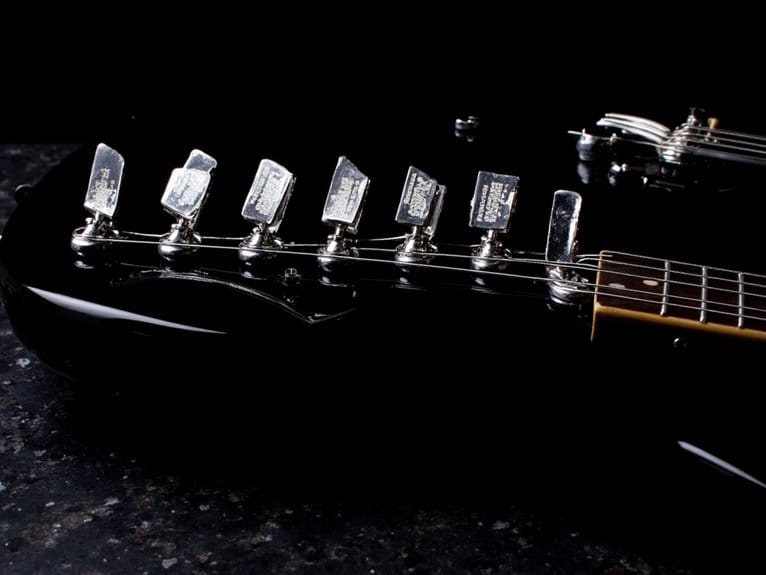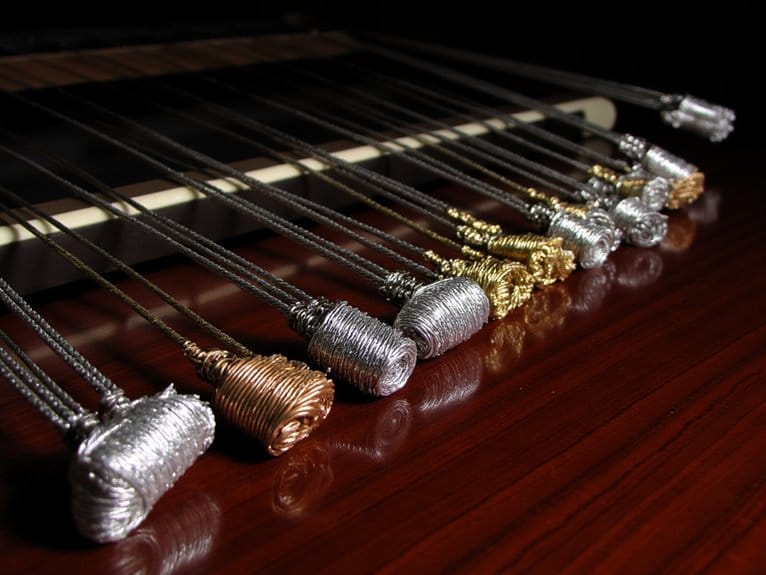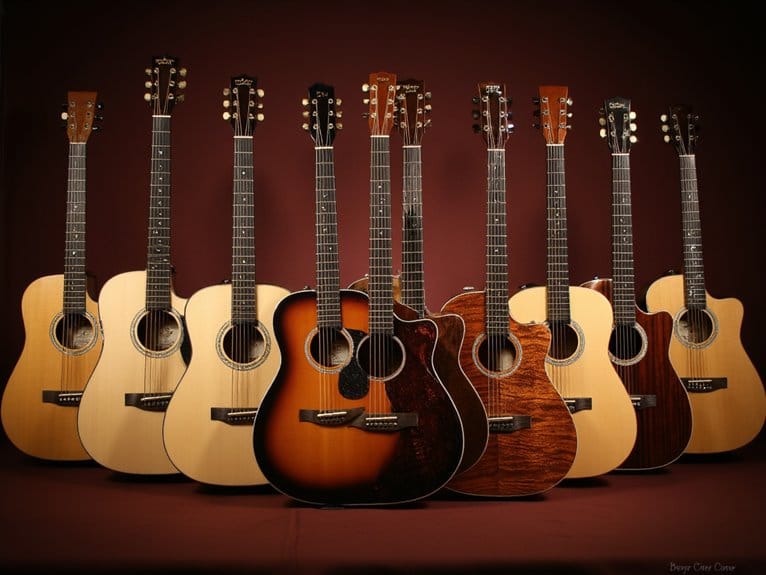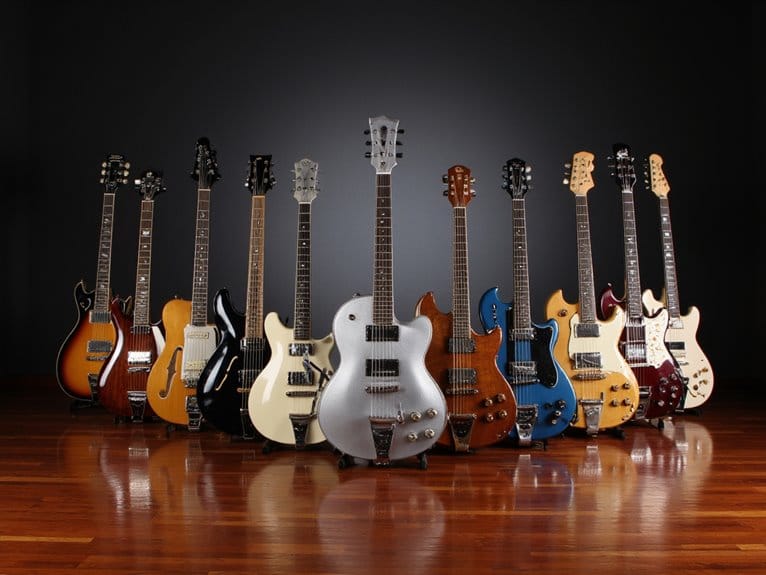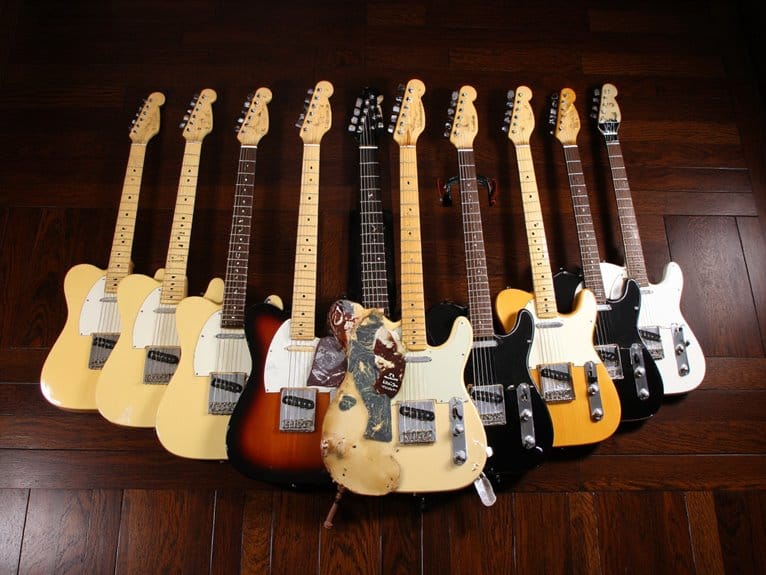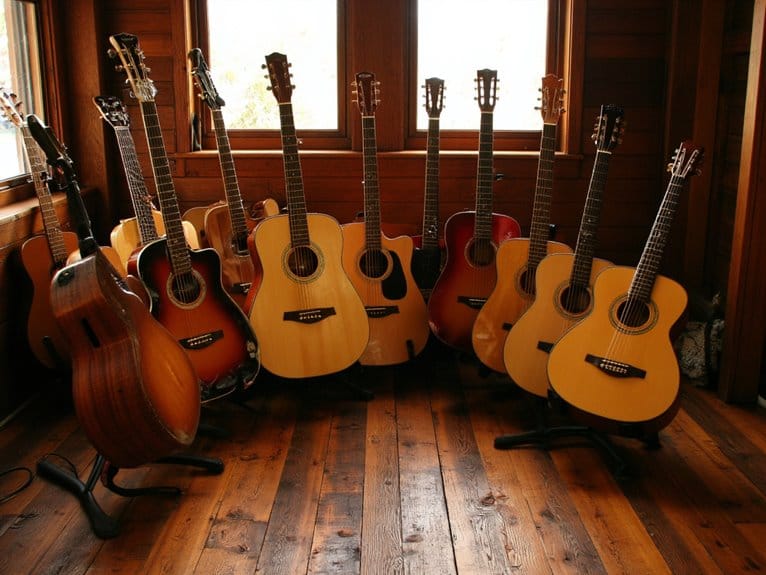Best Metal Guitar Strings for Maximum Shred and Durability
I’ve found that Ernie Ball Skinny Top Heavy Bottom strings deliver exceptional performance with their unique .010-.052 gauge configuration, offering the perfect balance between playability and aggressive tone that metal demands. Jim Dunlop Heavy Core strings excel in dropped tunings, maintaining clarity and sustain during the most punishing riffs, while D’Addario XL Nickel strings provide reliable durability for extended sessions. Each offers distinct advantages depending on your specific playing style and tonal preferences that I’ll explore further.
We are supported by our audience. When you purchase through links on our site, we may earn an affiliate commission, at no extra cost for you. Learn more.
Notable Insights
- Ernie Ball Skinny Top Heavy Bottom (.010-.052) offers hybrid playability with exceptional tuning stability, trusted by Metallica with 4.8/5 ratings.
- Jim Dunlop Heavy Core strings maintain clarity and sustain in dropped tunings like Drop C and B with superior durability.
- Heavier gauge strings (.011-.052) provide better sustain, volume, and resistance to detuning during aggressive metal playing styles.
- Nickel-plated steel construction delivers bright, balanced tone with quick attack and defined clarity essential for metal genres.
- Coated strings like Elixir’s NANOWEB offer extended lifespan by protecting against sweat, corrosion, and humidity during intense performances.
Ernie Ball Skinny Top Heavy Bottom Electric Guitar Strings (P02215)
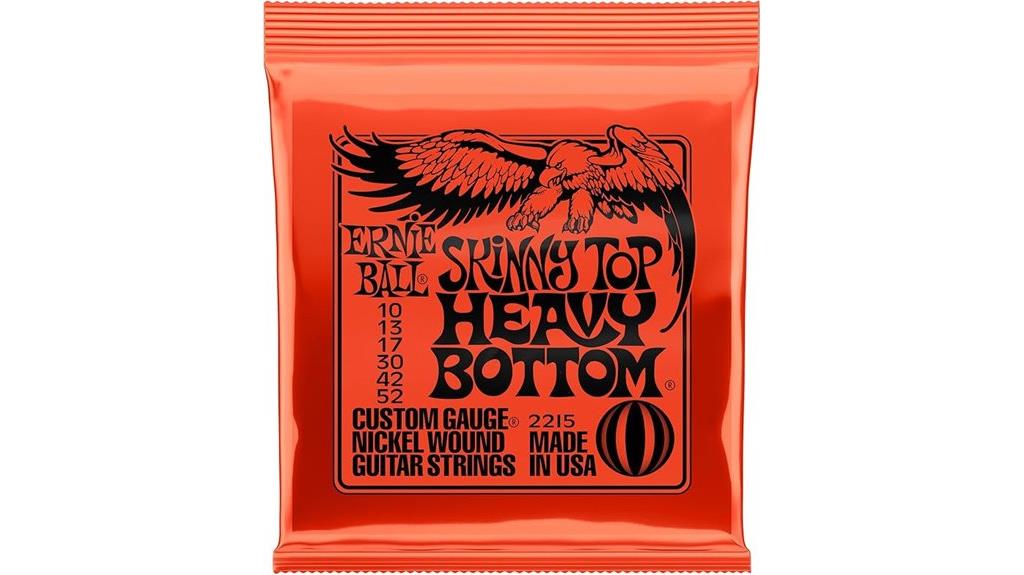
If you’re a metal guitarist who craves the crushing power of heavy bottom strings but refuses to sacrifice your ability to execute lightning-fast solos on the higher register, the Ernie Ball Skinny Top Heavy Bottom Electric Guitar Strings (P02215) represent the perfect hybrid solution for your demanding playing style. These California-made strings feature a unique .010-.052 gauge configuration, combining thinner trebles with substantially thicker bass strings for superior versatility. The nickel-plated steel construction delivers the bright, balanced tone that’s made them favorites of metal legends like Metallica, while the tin-plated hex core guarantees consistent tuning stability during aggressive playing sessions that’d destroy lesser strings.
Best For: Metal and rock guitarists who need heavy bottom strings for crushing riffs but want to maintain the flexibility of lighter top strings for fast solos and bends.
Pros:
- Hybrid gauge design (.010-.052) offers perfect balance between heavy rhythm tones and lead playability
- Exceptional tuning stability and durability thanks to nickel-plated steel construction with tin-plated hex core
- Trusted by legendary artists like Metallica and backed by outstanding customer ratings (4.8/5 stars from 121,277 reviews)
Cons:
- The gauge combination may require setup adjustments for guitars previously strung with standard sets
- Thicker bottom strings can be more challenging for beginners or players with lighter touch
- Higher string tension from heavy bottom strings may cause increased neck stress on some guitars
Jim Dunlop Heavy Core Electric Guitar Strings 10-48
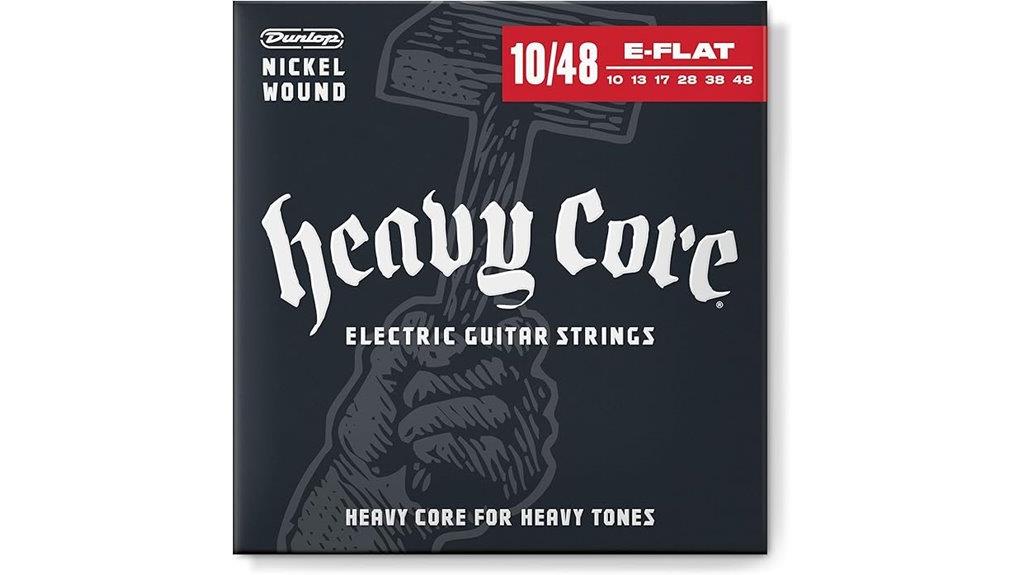
When you’re constantly battling tuning stability issues while playing in dropped or lower tunings, Jim Dunlop Heavy Core Electric Guitar Strings 10-48 offer a specialized solution that I’ve found particularly effective for metal and rock applications. These strings utilize unique core wire construction with proprietary wrap ratios, delivering tension similar to standard .010 gauge sets while maintaining clarity in lower tunings like Drop C and B. The nickel steel composition provides quick attack with defined low-end response, focused midrange, and smooth top-end characteristics that work equally well for clean passages and high-gain distortion. Users consistently report excellent sustain, pinch harmonic clarity, and remarkable durability against sweat and aggressive playing.
Best For: Metal and rock guitarists who frequently use dropped or lower tunings and need strings that maintain tuning stability and clarity while providing enhanced low-end response.
Pros:
- Specialized design maintains excellent tuning stability in dropped tunings like Drop C and B with tension similar to standard .010 gauge strings
- Superior durability and extended lifespan with resistance to sweat and aggressive playing styles
- Delivers exceptional sustain, pinch harmonic clarity, and defined low-end response perfect for metal and rock genres
Cons:
- May require amplifier or EQ adjustments due to the notably fat tone profile
- Primarily optimized for lower tunings, potentially limiting versatility for standard tuning applications
- Higher price point compared to standard electric guitar string sets
Jim Dunlop Heavy Core Trivium Signature Guitar Strings 10-52
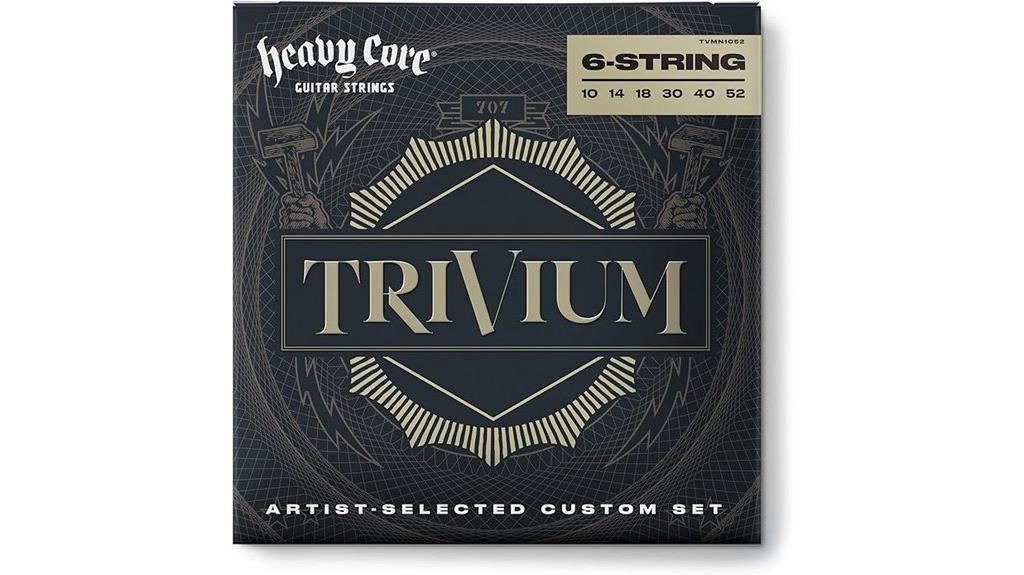
The Jim Dunlop Heavy Core Trivium Signature Guitar Strings 10-52 represent collaborative engineering at its finest, delivering the precise tonal characteristics that Matt Heafy and Corey Beaulieu demanded for their aggressive, downtuned metal compositions. You’ll appreciate how each string was individually selected in Dunlop’s String Lab, ensuring the set maintains tonal balance while providing exceptional tuning stability during heavy palm-muted riffs. The Heavy Core construction keeps your notes focused and punchy, even when you’re tuning down to drop C or lower, which honestly makes these strings worth considering if you’re serious about heavy music that requires consistent intonation and rich harmonic content.
Best For: Metal guitarists who frequently use downtuned guitars and need strings that maintain tuning stability and tonal balance during aggressive playing styles.
Pros:
- Excellent tuning stability specifically designed for downtuning applications
- Each string individually selected to ensure tonal balance across the entire set
- Heavy Core construction maintains note focus and punch even at lower tunings
Cons:
- Higher gauge strings (10-52) may feel stiff for players accustomed to lighter sets
- Signature set may be more expensive than standard string options
- Specifically engineered for metal styles, potentially limiting versatility for other genres
DAddario XL Nickel Electric Guitar Strings (EXL110-3D, 3-Pack)

Known throughout the guitar world since 1974, D’Addario’s XL Nickel Electric Guitar Strings represent what I consider the gold standard for musicians who demand consistent performance across multiple genres. The EXL110-3D’s nickel-plated steel construction delivers that bright, versatile tone you’ll need for metal’s aggressive demands, while their proprietary Hex-Core design guarantees your intonation stays locked down through the heaviest riffs. I’ve found these 10-46 gauge strings offer excellent resistance to breakage and corrosion, maintaining their punch even during extended sessions where you’re pushing both your amp and technique to the limit.
Best For: Guitarists across all skill levels who need reliable, versatile electric guitar strings that deliver consistent tone and performance for multiple genres from rock to metal.
Pros:
- Nickel-plated steel construction with Hex-Core design provides excellent intonation, durability, and resistance to breakage and corrosion
- Bright, versatile tone suitable for various musical genres with consistent sound quality over extended playing sessions
- Industry standard since 1974 with outstanding user ratings (4.8/5 stars) and proven reliability for both live performances and studio work
Cons:
- Subject to metal fatigue over time like all guitar strings, requiring eventual replacement regardless of quality
- 10-46 gauge may not suit players who prefer lighter or heavier string tensions for their specific playing style
- Limited to one gauge option in this specific 3-pack, requiring separate purchases for different tension preferences
Factors to Consider When Choosing Metal Guitar Strings
When I’m helping guitarists select the perfect strings for metal, I’ve learned that five critical factors consistently determine whether you’ll achieve that crushing tone you’re after. Your string gauge choice directly impacts your tuning stability, especially when you’re drop-tuning or using extended-range instruments, while your tonal preferences and playing style compatibility must align with the string’s construction materials and tension characteristics. I’ll walk you through each consideration, from durability expectations that affect your budget to specific gauge recommendations that complement everything from aggressive palm-muted riffs to soaring lead passages.
String Gauge Selection
String gauge selection forms the foundation of your metal guitar tone, and frankly, I’ve seen more guitarists struggle with this choice than almost any other gear decision. For metal, I recommend starting with .010 or .011 gauge sets, which provide that essential balance between playability and the heavy low-end response metal demands. Heavier gauges like .011-.052 deliver superior sustain and volume, particularly important for drop tunings where string tension matters greatly. While lighter .009 sets offer easier bending and faster runs, they often lack the punch needed for aggressive riffing and can feel flimsy under heavy picking. I’ve found that experimenting with different gauges reveals your personal sweet spot between comfort and tonal authority.
Tuning Stability Requirements
Once you’ve settled on your preferred gauge, maintaining consistent tuning becomes the next battle in your quest for metal perfection, and I’ll admit I’ve learned this lesson the hard way through countless studio sessions where my strings decided to go sharp mid-take. Heavier gauges naturally resist detuning better than lighter ones, particularly when you’re executing aggressive bends or palm-muted chugs that put serious stress on the strings. The material composition matters greatly here, as stainless steel and nickel-plated options offer superior resistance to oxidation and stretching compared to pure nickel variants. I’ve found that tightly wound construction prevents slipping during intense playing sessions, while proper installation and regular cleaning can extend tuning stability considerably, saving you from those embarrassing moments when your low E suddenly sounds like a fish.
Tonal Characteristics Preferences
While tuning stability keeps your performance from falling apart, the tonal character of your strings ultimately defines whether your metal riffs cut through the mix like a chainsaw or get buried under the bass like wet cardboard.
I’ve learned that string material dramatically shapes your sound signature, with nickel-plated steel delivering that balanced brightness most metal players crave. When I’m tracking aggressive rhythm sections, I prefer heavier gauges because they provide fuller low-end response that makes palm-muted riffs sound absolutely crushing. However, for lead work requiring extensive bends, lighter gauges offer brighter highs and easier playability.
The winding technique matters more than many realize – round wounds give you that aggressive bite perfect for distorted tones, while flat wounds offer smoother warmth better suited for cleaner passages. The alloy composition affects note definition too, making some strings better for precision playing versus others designed for sustained aggression.
Durability and Longevity
After destroying countless sets during aggressive downtuned sessions, I’ve discovered that string durability separates the weekend warriors from the serious metal players who can’t afford mid-song breakages during crucial performances. Material composition matters most, with nickel-plated steel and phosphor bronze offering superior corrosion resistance against sweat and humidity that plague extended practice sessions. Coated strings featuring proprietary protective layers dramatically extend lifespan, though they’ll cost more upfront than standard sets. I’ve found thicker gauges provide better breakage resistance under heavy palm-muting and aggressive picking, especially when drop-tuning requires additional tension stability. Regular maintenance, including wiping strings after each session, removes oils and grime that accelerate deterioration, making this simple habit essential for maximizing your investment.
Playing Style Compatibility
Three distinct playing approaches require completely different string setups, and I’ve learned this lesson through years of fighting against inappropriate gauge selections that hindered my technique development. Heavy rhythm players using dropped tunings need 10-52 or heavier gauges to maintain proper tension and deliver that crushing low-end punch metal demands. Lead guitarists focused on intricate solos benefit from lighter gauge strings like 10-46, which reduce finger fatigue during extended shredding sessions and make string bending markedly easier. Hybrid players who switch between aggressive rhythm work and complex leads face the toughest choice, often requiring medium gauges that compromise between playability and tonal density. I’ve found that matching your primary playing style to appropriate string tension dramatically improves both technique execution and overall sound quality.
On a final note
After testing countless metal guitar strings over the years, I’ve found that your choice ultimately depends on your playing style, genre preferences, and maintenance habits. Whether you’re shredding through aggressive riffs with heavy-gauge strings or seeking versatile tone with lighter sets, these options deliver exceptional durability and performance. I’d recommend starting with medium-gauge strings if you’re unsure, then adjusting based on your comfort level and sound requirements.

